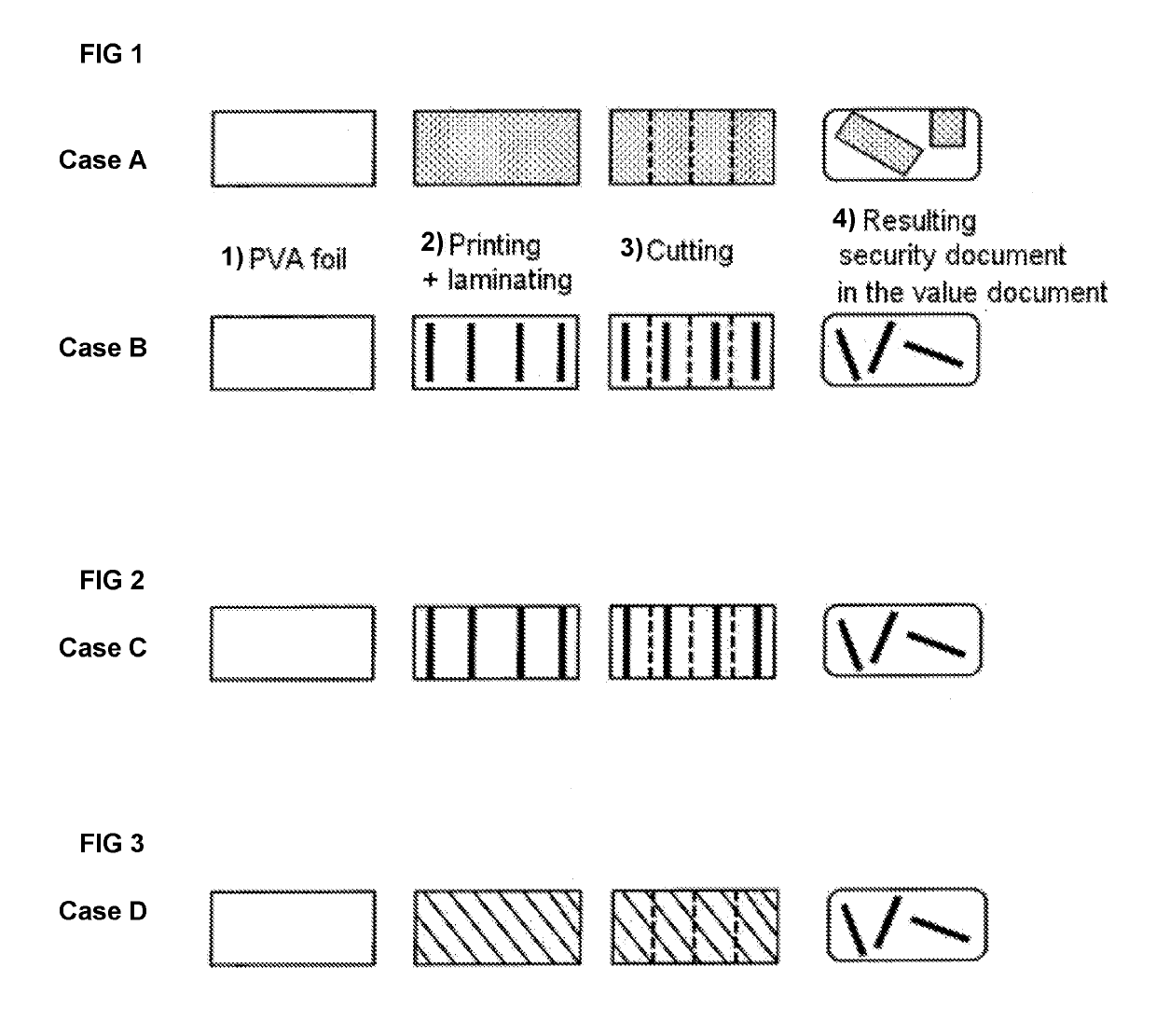Security element, method for producing the same and value document
a security element and value document technology, applied in the field of security elements, method for producing the same and value documents, can solve the problems of wear and tear of value documents, disturbing fragments, and remaining visible in paper stock
- Summary
- Abstract
- Description
- Claims
- Application Information
AI Technical Summary
Benefits of technology
Problems solved by technology
Method used
Image
Examples
embodiment example 1
tling Fibers
[0067]A PVA foil having a thickness of 25 μm is coated with a solution of 1 percent by weight of polyvinyl acetate having a molar mass of 140,000 g / mol, which contains 10 percent by weight of a UV-excitable, blue luminescent security pigment based on core-shell particles. Ethyl acetate is chosen as the solvent. The coating has a weight per unit area of 5 grams per square meter. After evaporation of the ethyl acetate, the applied layer is covered with a second PVA foil having a thickness of 25 μm and is laminated by passing through a hot metal roller. The laminated foil composite is subsequently cut into mottling fibers having a size of 5 mm×1 mm and introduced into the paper stock during the paper production.
[0068]A paper is obtained having mottling fibers recognizable as blue stripes under UV light.
[0069]The paper is subsequently recycled (at great shear forces; at 80° C.; at a pH value of 11; treatment duration: 1 hour). New paper is produced from the resulting paper s...
embodiment example 2
ttling Fibers
[0074]A PVA foil having a thickness of 30 μm is printed with a pattern of 5 mm long and 200 nm thick stripes. The printing ink employed is a mixture of acetone and 2 percent by weight of polyvinyl acetate having a molar mass of 200,000 g / mol, which contains 5 percent by weight of a UV-excitable, green luminescent security pigment based on core-shell particles.
[0075]The print thickness is 5 grams per square meter. After drying the print sample, it is covered with a second PVA foil having a thickness of 30 μm and is laminated by passing through a hot metal roller. The laminated foil composite is subsequently cut into pieces, wherein each piece contains a stripe of the printed stripe pattern, and is introduced into the paper stock during the paper production.
[0076]A paper is obtained having mottling fibers recognizable as green stripes under UV light.
[0077]The paper is subsequently recycled (great shear forces; 80° C.; pH 11; 1 hour). A new paper is produced from the resul...
embodiment example 3
s
[0078]A PVA foil having a thickness of 50 μm is coated with a solution of 1 percent by weight of polyvinyl acetate having a molar mass of 140,000 g / mol, which contains 10 percent by weight of an IR absorber pigment based on core-shell particles. The solvent used is ethyl acetate. The coating has a weight per unit area of 5 grams per square meter. After evaporation of the ethyl acetate, the applied layer is covered with a second PVA foil having a thickness of 50 μm and is laminated by passing through a hot metal roller. The laminated foil composite is subsequently cut into planchets having a size of 5 mm×5 mm and introduced into the paper stock during the paper production.
[0079]A paper is obtained which, when viewed with suitable devices, for example with an IR sensor for banknotes, exhibits corresponding places with IR absorption.
[0080]The paper is subsequently recycled (great shear forces; 80° C.; pH 11; 1 hour). A new paper is produced from the resulting paper stock. When viewed ...
PUM
 Login to View More
Login to View More Abstract
Description
Claims
Application Information
 Login to View More
Login to View More - R&D
- Intellectual Property
- Life Sciences
- Materials
- Tech Scout
- Unparalleled Data Quality
- Higher Quality Content
- 60% Fewer Hallucinations
Browse by: Latest US Patents, China's latest patents, Technical Efficacy Thesaurus, Application Domain, Technology Topic, Popular Technical Reports.
© 2025 PatSnap. All rights reserved.Legal|Privacy policy|Modern Slavery Act Transparency Statement|Sitemap|About US| Contact US: help@patsnap.com

